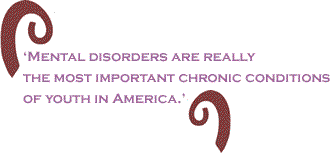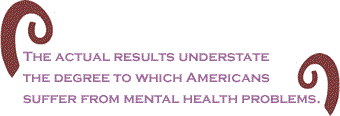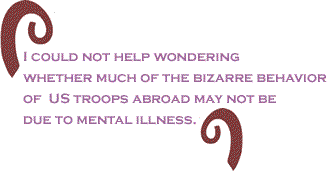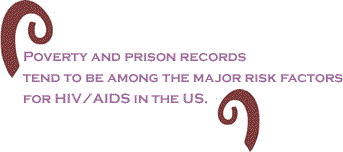
|
|||||||||||||||||||||
|
This article originally appeared in the Jamaica Observer. About two weeks ago there were news stories to the effect that one in four Americans were afflicted by mental illness and that fully a quarter of those were so seriously affected that their illnesses disrupted their ability to live normal lives. These stories were based on the first results of a worldwide study carried out by a team led by the Harvard professor of Mental Health, Ronald Kessler. Kessler says that the United states leads the world in mental ill-health: “We lead the world in a lot of good things, but we’re also leaders in this one particular domain where we’d rather not be.” The survey did not include some of the most serious mental disorders, such as schizophrenia and autism, so that the actual results understate the degree to which Americans suffer from mental health problems. About one in two Americans will develop a mental disorder at some time in their lives, the survey of nearly 10,000 U.S. adults found. Younger sufferers tended to be overlooked even though mental illness is typically a disease of youth. “Half of those who will ever be diagnosed with mental illness show signs of the disorder by age 14 and three quarters by age 24.”
"Mental disorders are really the most important chronic conditions of youth in America," said Professor Kessler, "Sadly ... these early onset disorders very seldom come to the attention of the treatment system unless they're very severe." Less than half of those in need of treatment ever get help. Those typically get treatment after a decade or more of trying to cope on their own – during which time they are likely to have developed additional problems. About a third of those affected relied on non-professional assistance. Part of the problem is the stigma of mental illness, the lack of medical insurance and the fact that most people ignore the early warning signs of mental disability. I must confess that as I read the reports I could not help wondering whether much of the bizarre behavior of US troops abroad may not be due to mental illness. Right after the Americans entered Baghdad I remember reading a New York Times story by Dexter Filkins quoting a young American soldier who told him that he had shot a young woman because she happened to be standing in the wrong place. Barbarous assaults on civilians, the shooting up of cars loaded with children and similar actions begin to be explicable if one understands that much of the US army consists of frightened young men who joined the army to get a job or an education, not to go abroad to kill people. Their training, particularly in the Marines, conditions them to believe that every civilian is a terrorist determined to kill. If they are suffering from antecedent states of pathological anxiety and depression their behavior becomes easier to understand, if not to forgive.
It also helps to explain why the Army finds it so easy to make scapegoats out of such as Lyndie England and the other poor, underprivileged young people involved in the tortures at Abu Ghraib and elsewhere. They are like Henry II’s knights, needing the merest hint to go off and commit mayhem. And their superiors, knowing this, are generous with their hints. Remember the American general who explained why the first detainees were transported to Guantanamo, manacled, shackled to the floor of the plane, blindfolded and gagged? They were the sort of folks “who will chew through the hydraulic lines of an aircraft. These are the Hannibal Lecters of south-west Asia.” If you identify the enemy in this way, as insensate robots, human piranhas with no appetite except for blood and death, it isn’t too not hard to imagine how impressionable young recruits with no great hold on reality will interpret their mandate. It’s simply “Nightmare on Elm Street” made flesh. And they will have heard and observed how casually their elders and betters dismissed the black holes and the massacres of Kunduz and Mazar al-Sharif. Falluja then becomes not a city of people to be pacified, but a nest of vipers to be exterminated and obliterated.
So, when a group of American soldiers – military police – were told in a training drill at Guantanamo Bay that a man in a yellow jump suit was a recalcitrant prisoner, they beat him to a pulp. Sergeant Sean Baker, a military policeman, said that as he was being choked and beaten he screamed a code word, "RED!!!" and shouted: "I'm a U.S. soldier! I'm a U.S. soldier!" But the beating continued until his jumpsuit was yanked down during the struggle, revealing his military uniform. Baker is suing the Department of Defense for $15 million for multiple injuries, including a fractured skull and a traumatic brain injury. Baker’s lawsuit charges: "Armed with the highly inflammatory, false, incendiary and misleading information that had been loaded into their psyches by their platoon leader, these perceptions and fears ... became their operative reality, and they acted upon these fears, all to the detriment of Sean Baker." It can hardly have surprised thinking Americans when it was revealed this week just how unpopular they are around the world. In Canada and Britain a majority – sadly diminished since 2002, but still a majority – have favorable opinions of the US. In most of the rest of the world most people do not have a good opinion of the US. Outside of the United States itself, only India and Indonesia believe that the foreign policy of the US considers anything but its own interests. Strange Fruit
In the sixties, that fabled time so many aeons ago, Black Power, Vietnam and Flower Power coexisted in the hearts and minds of the so-called Baby Boomers and lots of other people round the world. I was in London, where being tear-gassed or baton-charged and arrested was par for the course when you were defending human rights, assailing LBJ for the Vietnam war and making love, not war. One of our anthems then was a song by folksinger Tom Paxton entitled “Goodman and Schwerner and Chaney”, part of the true parable of three young men, a Jew, a Gentile and a black, three of the idealistic youth who invaded the southern states of the US trying to get black people registered to vote, trying to tear down the walls of American Apartheid. Last week, forty years almost to the day after the three young men were murdered and buried under 15 feet of farmyard soil, the man who planned their killing was finally sentenced to pay for his crime. But Edgar Ray Killen, a classic know-nothing fundamentalist part time preacher was not the real author of the killings. He was simply the excrescential expression of an American sub-culture which then was respectable and is once again becoming fashionable. American fascism has never been far below the surface of American life and before it came to be called fascism it was part of the slave owning, plantation ethos which depended upon parasitizing other kinds of people and other nations for its opulent existence. It was only three years ago that one of its main ideologists, Jesse Helms, withdrew his objection to the provision by the United States of foreign aid to help fight HIV/AIDS abroad, which is killing millions of people, mostly black, around the world. But he maintained his opposition to federal spending on HIV-AIDS inside the US, maintaining that AIDS would disappear if only people would give up their homosexual “lifestyles” Helms was no doubt aware that AIDS was extremely efficient at killing blacks and that the pandemic is apreading fastest among women. Last week there was an important development of interest in the area of HIV/AIDS. It did not appear to concern HIV/AIDS at all, but it did. This development was the licensing by the Food and Drug Administration of a drug to treat a particular ethnic group, African Americans with certain kinds of heart disease. Scientists cannot explain why one drug should be so much more effective in people of one ethnic background than in others. But there was a clue in 2003 when a vaccine designed to immunize against HIV/AIDS turned out to be several times more effective among blacks than among any other ethnic group. Reporting the story two years ago, the New York Times headline was “Large Trial Finds AIDS Vaccine Fails to Stop Infection” – which was why most people missed it. The lead paragraph was “ The first AIDS vaccine ever to be tested in a large number of people has failed, over all, to protect them from infection with the virus that causes the disease, the company that makes it, VaxGen, said today.”
The real news was in the second paragraph :”The vaccine did, however, seem to significantly lower the infection rate among African-Americans and other non-Hispanic minorities participating in the trial, the company said”. But after the headline and the first paragraph, who would have read further? Researchers called the finding totally unexpected and said they were at a loss to explain why there would be ethnic differences in response to the vaccine. One would have expected that the scientists would immediately have tried more ambitious testing among blacks, who are the most at risk of AIDS. Poverty and prison records tend to be among the major risk factors for HIV/AIDS in the US and blacks are overwhelmingly poor and form a disproportionate component of the prison population. Perhaps the vaccine could be tested in prisons?. But no. The scientists have gone back to study the “problem.” Dr. Anthony Fauci, the famous director of the National Institute of Allergy and Infectious Diseases said the trial statistics seemed impressive, but scientists would need to determine whether the protective benefits were due to a statistical fluke or some unexplained biological or behavioral factor. According to UNAIDS, in 2002 only 30,000 people out of almost 30 million living with HIV/Aids in sub-Saharan Africa were being given the drugs that in the West keep infected men and women alive, well and working for years. In Botswana 40% of the population is HIV-positive and every second pregnant woman is infected. Meanwhile, it should please cat fanciers everywhere to know that a working vaccine against FIV – feline immunodeficiency virus – has been developed and was licensed for veterinary use three years ago. The FIV virus is similar to the HIV virus and has similar effects on infected cats. I kid you not. John Maxwell of the University of the West Indies (UWI) is the veteran Jamaican journalist who in 1999 single-handedly thwarted the Jamaican government's efforts to build houses at Hope, the nation's oldest and best known botanical gardens. His campaigning earned him first prize in the 2000 Sandals Resort's annual Environmental Journalism Competition, the region's richest journalism prize. He is also the author of How to Make Our Own News: A Primer for Environmentalists and Journalists. Jamaica, 2000. He can be contacted at [email protected]. Copyright ©2005 John Maxwell |
Your comments are always welcome. Visit the Contact Us page to send e-Mail or Feedback or Click here to send e-Mail to [email protected] e-Mail re-print notice
If you send us an e-Mail message we may publish all or part of it, unless you tell us it is not for publication. You may also request that we withhold your name. Thank you very much for your readership. |
| June 30 2005 Issue 144 |
|||||||||
|
|||||||||
|
|
|||||||||
| Printer Friendly Version | |||||||||
 |
|||||||||
 |
|||||||||
| |
|||||||||
| |
|||||||||





























